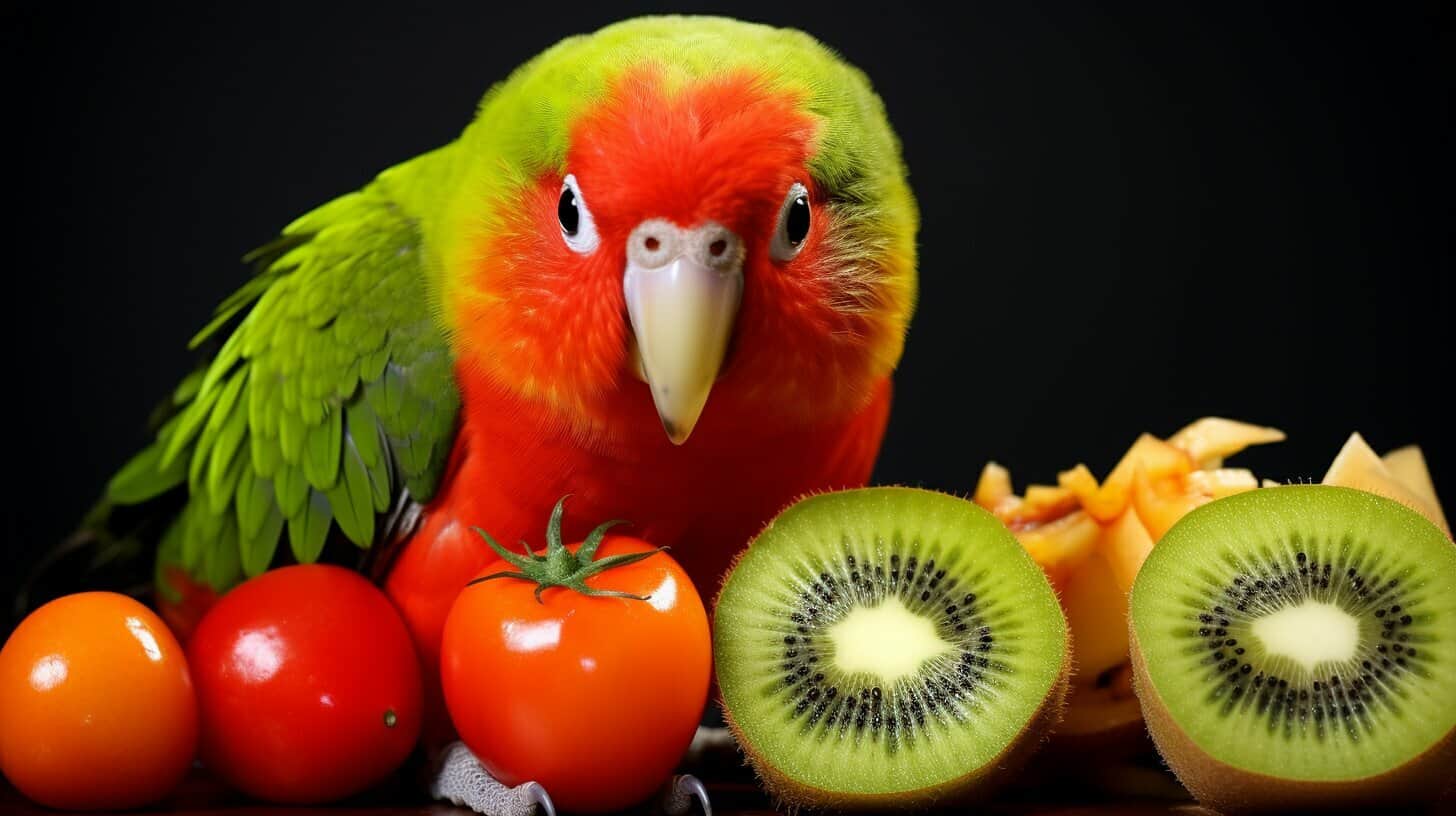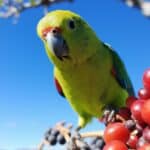As a bird owner, you may be wondering if it’s safe to feed your feathered friend carrots. Kakarikis, in particular, have specific dietary requirements that must be met to ensure their health and wellbeing.
In this article, we will explore the benefits and risks of feeding kakarikis carrots and provide a comprehensive guide to a healthy diet for your beloved pet.
Can kakarikis eat carrots? Yes, kakarikis can eat carrots. Like many other parrots, Kakarikis enjoy a varied diet that includes fresh vegetables. Carrots provide them with essential vitamins and minerals beneficial for their overall health. When offering carrots to your kakariki, it’s advisable to serve them raw and finely chopped or shredded, ensuring no pesticides or chemicals are present.
Key Takeaways
- Feeding kakarikis a balanced diet is essential to their overall health.
- Carrots can be safely incorporated into their diet in moderation.
- A diverse range of foods, including fruits, vegetables, and seeds, should be included in their diet.
Understanding the Kakariki Diet
Like all birds, Kakarikis have specific nutritional requirements that must be met to maintain their overall health and well-being. Understanding the kakariki diet is essential to ensuring that their dietary needs are being met.
A balanced kakariki diet consists of a combination of seeds, fruits, vegetables, and proteins. Seeds should make up most of their diet, as they are high in fat and provide essential energy. However, it is important to note that not all seeds are created equal, and some types may be too high in fat or lack the necessary nutrients.
In addition to seeds, kakarikis require fruits and vegetables to provide essential vitamins and minerals. Leafy greens such as spinach and kale are excellent sources of calcium and vitamins A, C, and K, while fruits such as apples and berries provide important antioxidants and fibre.
| Food Group | Examples |
|---|---|
| Seeds | Millet, sunflower seeds, hemp seeds |
| Fruits | Apples, berries, grapes |
| Vegetables | Kale, spinach, carrots |
| Proteins | Eggs, cooked chicken, mealworms |
Protein is essential to the kakariki diet, providing necessary amino acids for growth and development. Protein sources such as cooked chicken or eggs can be offered to kakarikis in small amounts, while mealworms or crickets can be given as occasional treats.
In addition to the specific food groups, it is important to ensure that kakarikis have access to fresh, clean water at all times.
They should also be offered a variety of foods to ensure they receive all necessary nutrients, and portion sizes should be appropriate for their size and activity level.
Exploring Carrots as a Potential Food for Kakarikis
Carrots are a popular vegetable that are known for their high content of vitamin A, which is essential for maintaining good vision, skin health, and a robust immune system. As a result, you may be wondering if carrots are suitable for your pet kakariki.
So, can kakarikis eat carrots? The answer is yes; Kakarikis can eat carrots andthey can be a valuable addition to their diet. Carrots are a good source of vitamin A, and minerals such as potassium and calcium.
However, it’s essential to note that carrots should not be the only food in your kakariki’s diet. While carrots can provide some nutritional value, they are low in protein and fat, which are crucial for your kakariki’s health.
| Pros | Cons |
|---|---|
|
|
It’s also essential to ensure that you feed carrots to your kakariki in moderation. While carrots do contain beneficial vitamins and minerals, overfeeding can lead to digestive issues such as diarrhoea, as carrots are high in fiber. As a general rule of thumb, it is best to feed carrots as a treat and not as a primary food source.
How to Feed Carrots to Your Kakariki
If you want to incorporate carrots into your kakariki’s diet, it’s best to start gradually. Introduce small pieces of carrots a few times a week and monitor their reaction. If your kakariki displays any signs of digestive discomfort, stop feeding carrots and consult with a veterinarian.
Another way to offer carrots to your kakariki is to chop them into small pieces and mix them with other fruits and vegetables. This can provide a varied and nutritious meal for your kakariki.
Carrots can be a healthy and valuable addition to your kakariki’s diet, but it’s essential to follow the guidelines provided here and introduce them in moderation. By offering your kakariki a diverse range of healthy foods and monitoring their portion sizes, you can ensure they receive a well-rounded and balanced diet that supports their well-being and happiness.
The Benefits of Carrots for Kakarikis
Carrots can be beneficial to your kakariki’s diet when incorporated in moderation. Aside from being a delicious treat for your feathered friend, carrots contain essential vitamins and minerals that can contribute to their overall health and well-being. Here are some of the potential benefits of feeding carrots to your kakariki:
| Benefit | Description |
|---|---|
| Rich in Vitamin A | Carrots are a great source of Vitamin A, which is vital for maintaining your kakariki’s eye health and vision |
| High in Fiber | Fiber plays a crucial role in maintaining your kakariki’s digestive system, and carrots are a good source of this essential nutrient |
| Packed with Antioxidants | Carrots contain powerful antioxidants that can help to boost your kakariki’s immune system and fight off harmful toxins and free radicals |
| Low in Calories | Carrots are a low-calorie snack, making them an excellent option for maintaining your kakariki’s weight and preventing obesity |
While carrots can provide your kakariki with plenty of health benefits, it’s essential to remember that they should be given as part of a balanced diet. Too many carrots can cause digestive issues and potentially lead to obesity. Generally, carrots should make up no more than 10% of your kakariki’s total diet.
It’s also important to note that while carrots are a good option, they should not be the only fruit or vegetable in your kakariki’s diet. Variety is key, and you should offer a diverse selection of fruits and vegetables to ensure a well-rounded nutritional intake.
Potential Risks and Considerations
While carrots can be a healthy addition to a kakariki’s diet, there are certain risks and considerations to keep in mind.
Allergies
Just like humans, some kakarikis may have allergies or sensitivities to certain foods. Introducing new foods gradually and monitoring your kakariki’s reaction is important.
Digestive Issues
Overfeeding or introducing new foods too quickly can lead to digestive issues, such as diarrhoea or constipation. Ensure you follow portion guidelines and gradually introduce new foods to their diet.
Portion Control
While carrots are packed with nutrients, too much of a good thing can be harmful. Carrots are high in sugar, leading to obesity and other health issues if not portioned correctly. Follow the recommended serving size based on your kakariki’s weight.
Balanced Diet
While carrots can contribute to a balanced diet, it’s important to ensure your kakariki receives a diverse range of foods to meet their nutritional needs. Incorporate other fruits, vegetables, proteins, and carbohydrates into their diet to ensure they get the necessary nutrients.
Consult with a Vet
If you are unsure about incorporating new foods into your kakariki’s diet or have any concerns about their overall health, it’s always best to consult with a vet who has experience with birds.
Creating a Balanced Diet for Your Kakariki
When creating a healthy and balanced diet for your kakariki, it’s essential to understand the different food groups they require and the appropriate portion sizes and feeding frequency. A balanced diet should contain proteins, carbohydrates, fruits, and vegetables.
Proteins: The primary protein sources for kakarikis are insects, egg, and chicken. These foods should make up approximately 10% of their diet.
Carbohydrates: Kakarikis require carbohydrates for energy and can obtain them from foods such as sweet potato, rice, and pasta. These foods should make up approximately 50% of their diet.
Fruits and Vegetables: Fruits and vegetables provide essential vitamins and minerals, and should make up approximately 40% of their diet. Suitable fruits include apple, pear, and banana, while suitable vegetables include spinach, carrot, and broccoli.
It’s important to monitor the portion sizes and frequency of feeding to prevent overfeeding, which can lead to obesity and related health issues. A good rule of thumb is to feed your kakariki approximately two teaspoons of food per day, split into two meals.
Additionally, it’s essential to ensure your kakariki has access to fresh water at all times, changing it daily to maintain its cleanliness.
Other Recommended Foods for Kakarikis
While carrots can be a great addition to your kakariki’s diet, it’s important to offer a variety of other foods to ensure they receive all the necessary nutrients. Here are some other recommended fruits, vegetables, and seeds for your pet:
| Fruits | Vegetables | Seeds |
|---|---|---|
| Apples | Broccoli | Millet |
| Bananas | Carrots (in moderation) | Sunflower seeds |
| Blueberries | Kale | Canary seeds |
| Mango | Spinach | Flax seeds |
| Papaya | Sweet potato | Chia seeds |
It’s important to offer your kakariki a diverse range of foods, as this will help prevent boredom and ensure they receive all the necessary nutrients. When introducing new foods, be sure to do so gradually and monitor your pet’s reaction.
Remember that while fruits and vegetables are an important part of a kakariki’s diet, they should not make up all their meals. Be sure to offer various proteins and carbohydrates to ensure a balanced diet.
Feeding Tips and Tricks
Feeding your kakariki can be a fun and rewarding experience for both you and your pet. Here are some tips and tricks to ensure the feeding process runs smoothly:
- Variety is Key: Kakarikis thrive on a diverse range of foods, so try to incorporate different fruits, vegetables, and seeds into their diet. This will keep them interested and engaged with their food.
- Portion Control: It’s essential to monitor the quantity of food you give to your kakariki to avoid overfeeding. Overfeeding can lead to obesity and other health issues, so be mindful of portion sizes.
- Watch for Behavioural Cues: Pay attention to your kakariki’s body language and eating habits. If they are leaving food uneaten or seem uninterested in their food, it may be a sign to switch up their diet or feeding routine.
- Feed at Regular Intervals: Consistency is key when it comes to feeding. Try to establish a regular feeding routine for your kakariki, such as feeding at the same time each day, to help them maintain a healthy appetite.
- Food Presentation: Kakarikis are visual eaters, so the presentation of their food can make a big difference. Try serving their food in different ways to see what they enjoy, such as hanging vegetables or presenting seeds in a feeding toy.
- Feeding Methods: Various feeding methods are available, such as scatter feeding or presenting food on a plate. Experiment with different methods to find what works best for your kakariki.
By taking these feeding tips and tricks into consideration, you can ensure that your kakariki is receiving a healthy, balanced diet that supports their overall health and wellbeing.
Conclusion
In conclusion, if you’re wondering “can kakarikis eat carrots?”, the answer is yes! Incorporating carrots into your pet kakariki’s diet can provide a range of benefits, such as boosting their immune system and improving their digestive health. However, monitoring portion sizes and balancing their diet with other suitable fruits, vegetables, and seeds is essential.
You can help your kakariki maintain their health and happiness by ensuring a balanced and nutritious diet. Remember always to provide fresh, clean water and offer a variety of foods to keep their diet interesting. With these guidelines and feeding tips, you can provide your pet kakariki with a healthy and enjoyable life.
FAQ
Q: Can kakarikis eat carrots?
A: Kakarikis can eat carrots as part of a balanced diet.
Q: What can kakarikis eat?
A: Kakarikis can eat various foods, including fruits, vegetables, and seeds.
Q: What is the importance of a balanced diet for kakarikis?
A: A balanced diet is crucial for kakarikis as it provides the necessary nutrients for overall health and well-being.
Q: Are carrots a suitable food source for kakarikis?
A: Carrots can be a suitable food source for kakarikis as they contain essential vitamins and minerals.
Q: What are the benefits of carrots for kakarikis?
A: Carrots can benefit kakarikis by supporting their immune system, digestive system, and eye health.
Q: Are there any risks or considerations when feeding kakarikis carrots?
A: Yes, it is important to consider allergies, digestive issues, and portion control when incorporating carrots into a kakariki’s diet.
Q: How can I create a balanced diet for my kakariki?
A: To create a balanced diet for your kakariki, include a variety of food groups such as proteins, carbohydrates, fruits, and vegetables. Follow guidelines on portion sizes and frequency of feeding.
Q: What other foods are recommended for kakarikis?
A: Aside from carrots, other recommended foods for kakarikis include a range of fruits, vegetables, and seeds.
Q: What are some feeding tips and tricks for kakarikis?
A: Some feeding tips and tricks for kakarikis include using different feeding methods, properly presenting food, and observing behavioural cues related to their diet.



Have comments or questions about this article? Then get involved!
Spotted an error or something we have missed? Let us know